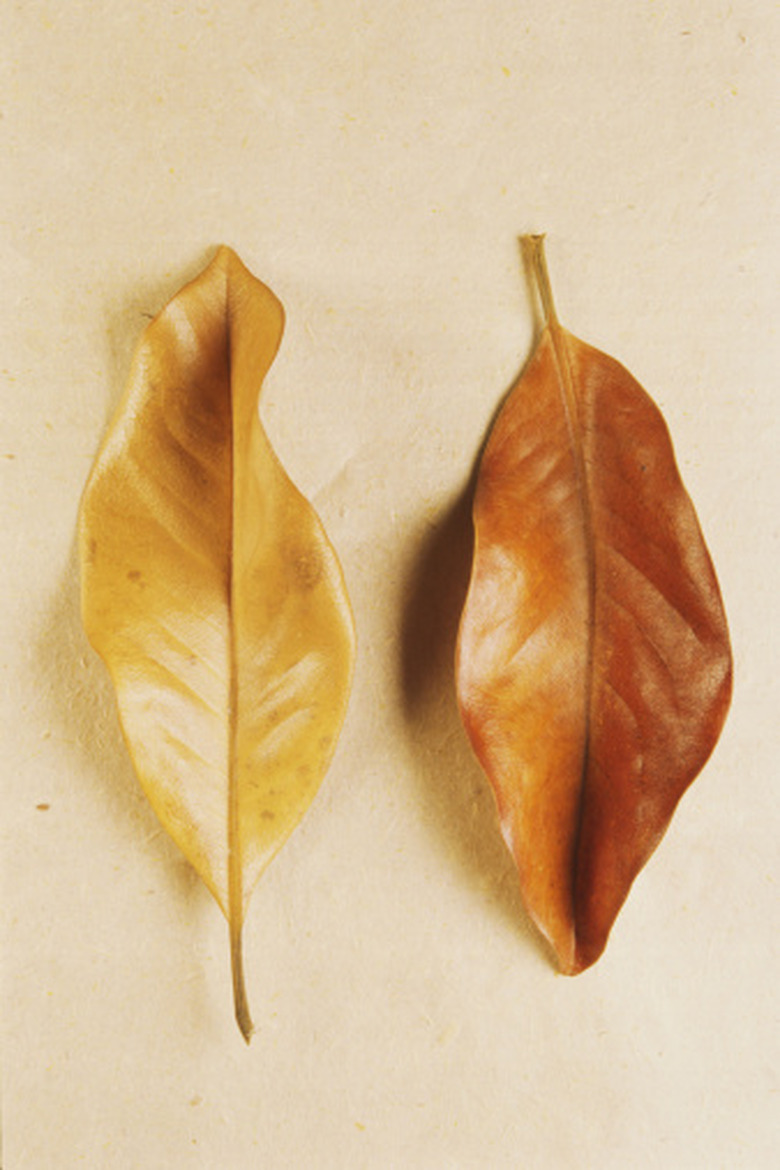Facts About A Magnolia Leaf
While the flowers are certainly a highlight of the southern magnolia (Magnolia grandiflora), the evergreen leaves are a large part of this tree's ornamental appeal. Grown in U.S. Department of Agriculture plant hardiness zones 6b through 9, the southern magnolia serves varied functions in a landscape. The foliage of this tree can become one of its more exasperating features when it finally does fall off as new replacement leaves grow in.
Features
Magnolia leaves grow on the stems in an alternate arrangement. They are simple leaves with an elliptical shape. Between 5 and 10 inches in length, the leaves are from 2 to 5 inches wide. Magnolia leaves feel thick and leathery; the leafstalks attaching them to the branches are stout and have a coating of hairs. The leaf margins (edges) are what botanists term "entire," meaning they lack any serrations.
- While the flowers are certainly a highlight of the southern magnolia (Magnolia grandiflora), the evergreen leaves are a large part of this tree's ornamental appeal.
- Magnolia leaves feel thick and leathery; the leafstalks attaching them to the branches are stout and have a coating of hairs.
Colors
The upper surface of a southern magnolia leaf is a glossy shade of dark green, but the leaf underside is paler green, often with a coating of fine brown hairs that give it a rusty appearance. Cultivars of the southern magnolia have subtle differences in their leaf colors. "Little Gem" has shiny green leaves with brownish-bronze underside coloring. "Edith Bogue" has similar colors, but the undersides are a bit lighter. "Bracken's Brown Beauty" has bi-colored foliage — green on top but rust-brown beneath.
Problems
Magnolias are by no means a "tidy" tree, notes the Washington State University Clark County Extension. The leaves on the magnolia normally fall off in the springtime as new foliage grows on the stems to take its place. The leaves are very slow to decompose, creating a mess under the magnolia that requires a clean-up. Leaving the foliage in place beneath the tree results in a layer of leaves so thick nothing will grow under it — including grass.
- The upper surface of a southern magnolia leaf is a glossy shade of dark green, but the leaf underside is paler green, often with a coating of fine brown hairs that give it a rusty appearance.
- The leaves are very slow to decompose, creating a mess under the magnolia that requires a clean-up.
Leaves of Other Magnolias
Other magnolia tree suitable for landscaping jobs have leaves with varying features. For example, the cucumber magnolia (Magnolia acuminata) has deciduous leaves as long as 12 inches, with a yellow-green color. The foliage of the sweetbay magnolia (Magnolia virginiana) is evergreen in the warmth of the Deep South, but falls off in the northern regions where it grows. The star magnolia (Magnolia stellata) is deciduous, with its dark green leaves going to yellow-brown before coming off late in autumn, making a mess on the ground.
References
- Missouri Botanical Garden: Magnolia Stellata
- Washington State University Clark County Extension: Southern Magnolia
- Missouri Botanical Garden: Magnolia Grandiflora Edith Bogue
- Missouri Botanical Garden: Magnolia Grandiflora Bracken's Brown Beauty
- Missouri Botanical Garden: Magnolia Grandiflora Little Gem
